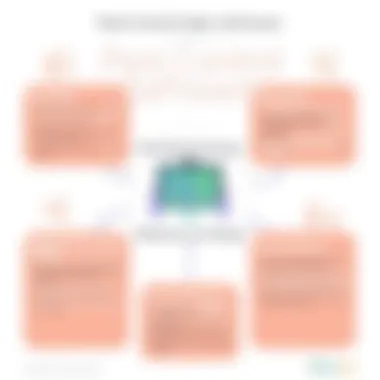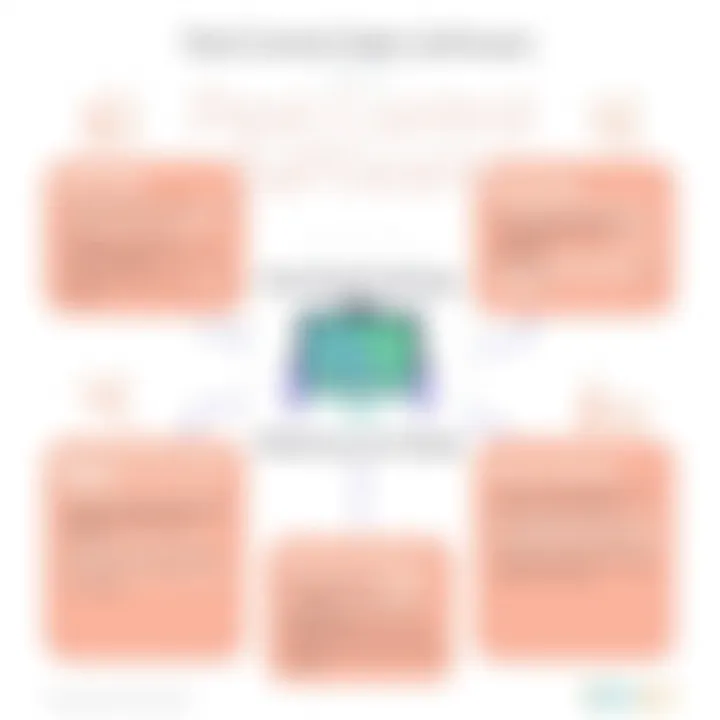Exploring Pest Control Sales Software for Business Growth


Industry Overview
The pest control industry has evolved significantly over the years. As urbanization expands and pest populations adapt, the need for effective management strategies has never been more critical. Software tailored for pest control sales is a key player in ensuring businesses operate smoothly. Such solutions not only enhance the efficiency of day-to-day operations but also empower sales teams to connect with customers in a more meaningful way.
Current Trends in the Industry-specific Software Market
Technological advancements have paved the way for new software solutions that cater specifically to the unique challenges of pest control businesses. Notable trends shaping this landscape include:
- Mobile Access: With a surge in field technicians needing real-time data, mobile features have become essential.
- Automated Scheduling: Software that automates service scheduling reduces human error and improves client satisfaction.
- Customer Relationship Management (CRM): Integration with CRM systems helps retain and engage customers effectively.
Key Challenges Faced by Buyers in the Industry
Despite the promising landscape, many organizations grapple with challenges when selecting software. Here are a few:
- Lack of Standardization: Many software options vary greatly, making it hard to evaluate them on a common ground.
- Resistance to Change: Employees may resist new systems due to a lack of understanding or fear of the unfamiliar.
- Budget Constraints: Small to mid-sized companies often struggle to find affordable solutions that meet all their needs.
Emerging Technologies Impacting the Industry
As pest control adapts to new realities, various technologies emerge, influencing its future:
- Artificial Intelligence: AI-driven analytics can predict pest behavior, leading to more effective intervention strategies.
- Internet of Things (IoT): Smart traps and devices can provide real-time data, enhancing monitoring and response efforts.
- Drones: In large properties or inaccessible areas, drones can survey and identify pest issues, making treatments more targeted.
Top Software Options
In a crowded marketplace, distinguishing the best software can feel like finding a needle in a haystack. Let's look at key players here.
Review of Leading Software Providers in the Industry
Some software solutions stand out in the pest control sector:
- PestRoutes: Renowned for its user-friendly interface and robust CRM features.
- PestPac: Offers comprehensive tools for scheduling, routing, and invoicing.
- TCG: This provides excellent mobile capabilities, allowing technicians to access key information on-the-go.
Feature Comparison of Top Software Solutions
When examining top products, feature sets often differ considerably. Here's a quick comparison:
| Feature | PestRoutes | PestPac | TCG | | Mobile Access | Yes | Yes | Yes | | Automated Scheduling | Yes | Yes | No | | CRM Integration | Yes | Yes | Yes | | Custom Reports | Yes | No | Yes |
Pricing Structures of Different Software Options
Understanding pricing can often feel like an uphill battle. Here’s a rough idea:
- PestRoutes: Generally priced based on a monthly subscription model, starting from around $100 per user.
- PestPac: Offers tiered pricing; larger companies may find this beneficial.
- TCG: Usually provides a flat fee that includes all features, often seen as a good deal for smaller businesses.
Selection Criteria
Once you’ve identified several promising options, knowing what factors matter most when selecting software is crucial.
Important Factors to Consider When Choosing Software
When selecting software, keep these points in mind:
- Usability: Is the interface intuitive for all employees?
- Scalability: Can the software grow with your business needs?
- Customer Support: What kind of support remains available post-purchase?
Common Mistakes to Avoid During the Selection Process
Making choices without proper research can be detrimental. Watch out for these pitfalls:
- Ignoring Customer Feedback: Always consider reviews and testimonials.
- Overlooking Training Needs: Ensure there is a comprehensive onboarding plan included.
- Disregarding Integration Issues: Confirm the software plays well with other systems you currently use.
How to Determine the Right Fit for Your Business Needs
Each pest control business has unique requirements. To find the right fit, you might consider:
- Trial Periods: Make use of demos to test software before committing financially.
- Consult with Stakeholders: Engage your team during the decision-making process.
- Future Needs Assessment: Think beyond current requirements and evaluate future needs.
Implementation Strategies
After you’ve selected the right software solution, attention shifts towards implementation.
Best Practices for Smooth Implementation of Software Solutions
For a hassle-free transition:
- Plan Ahead: Outline clear steps and timelines well before implementation.
- Engage Users: Involve the team during the rollout phase to get buy-in.
- Monitor Progress: Keep track of issues and adjustments needed along the way.
Integration with Existing Systems and Processes


Merging new software with existing systems can involve complexities:
- Identify Key Interfaces: Ensure the new software integrates seamlessly with established tools.
- Conduct Comprehensive Testing: Before full deployment, verify that all systems are functioning harmoniously.
Training and Support Resources for Successful Deployment
Adequate training is the foundation of successful software adoption:
- Initial Training: Provide comprehensive training sessions for all employees during the initial rollout.
- Ongoing Support: Establish channels for continued support post-implementation.
Future Trends
Looking ahead, it’s evident that pest control software will continue to evolve.
Predictions for the Future of the Industry-specific Software Landscape
Several advancements are anticipated:
- Increased Automation: Routine tasks will increasingly be handled by automated systems, freeing staff for more complex issues.
- Enhanced Data Utilization: Data analytics will be leveraged more extensively for decision-making.
Upcoming Technologies Shaping the Industry
Future technological advancements may include:
- Augmented Reality (AR): Offering virtual training experiences for technicians.
- Blockchain: For enhanced data security, especially vital in client relationships.
Recommendations for Future-Proofing Your Technology Stack
To stay ahead in this rapidly evolving field, businesses should:
- Invest in Flexible Systems: Opt for software that allows customization and upgrades.
- Stay Informed of Industry Trends: Regularly follow industry publications and websites such as Pest Control Technology for the latest insights.
This comprehensive exploration of pest control sales software underscores not only the importance of sophisticated systems but also the wider implications for operational success. Many businesses can find significant advantages by carefully selecting and implementing the right solutions for their unique contexts.
Prologue to Pest Control Sales Software
Pest control sales software is gaining traction in today's fast-changing market landscape. As the pest management industry sees increased competition, the ability to streamline operations isn't just an added bonus; it's a necessity. Implementing effective software can be the difference between staying afloat and sinking in a sea of disorganization. It's essential for professionals in the field to not only grasp the mechanics of the software but also understand how it integrates into their overall business strategy.
Defining Pest Control Sales Software
When we talk about pest control sales software, we are referring to specialized digital solutions designed to assist businesses in the pest management sector. These tools manage areas like sales tracking, customer interactions, and field technician scheduling more effectively. With intuitive dashboards and user-friendly interfaces, the software optimizes workflow, making day-to-day management much more manageable.
For instance, instead of relying on scattered spreadsheets or cumbersome paper forms, pest control companies can consolidate their processes into one platform. This centralized approach allows for accurate tracking of leads, customer data, and service schedules in real-time—providing invaluable insights for companies aiming to step up their game.
Importance in the Pest Management Industry
The pest management industry is uniquely competitive, with businesses vying for the attention of potential clients. In such an environment, having effective sales software can give one company a critical edge. This software enhances efficiencies by automating ordinary tasks that can otherwise consume hours of employee time.
For example, automated reminders for follow-ups can drastically improve customer retention rates. Furthermore, analytics tools embedded in the software can present actionable data that inform marketing strategies and service improvements. Adoption of such technology in pest control is not just about keeping pace with trends; it’s about future-proofing their operations.
- Benefits include:
- Enhanced productivity
- Improved accuracy in reporting and tracking
- Strengthened customer relationships through personalized service
In essence, pest control sales software isn't merely a tool; it's an essential partner in a company's growth mission. Understanding its definition and significance can arm professionals with the knowledge needed to elevate their operations profoundly. As the saying goes, "Time is money," and in the pest management field, using technology wisely can save both.
Key Features of Pest Control Sales Software
Pest control sales software is built to address specific needs in a sector that grapples with both competition and complexity. Understanding the key features of this software is crucial not just for streamlining processes but also for empowering teams to maximize their productivity. Each feature serves a distinct purpose, paving the way for increased efficiency and better interactions with clients. As we delve into the essential elements of pest control sales software, the benefits become clear, demonstrating why these tools are pivotal in today’s pest management landscape.
Lead Management Capabilities
Lead management capabilities within pest control sales software form the backbone of any effective sales strategy. Imagine a scenario where your sales team is inundated with leads from various channels. Without a robust system to keep track of these leads, crucial opportunities could slip through the cracks. This is where lead management shines.
A functional lead management system helps in:
- Qualifying leads: By assessing leads based on their likelihood to purchase, businesses can allocate resources more effectively.
- Tracking interactions: Monitoring every touchpoint with a lead ensures a personalized approach, leading to higher conversion rates.
- Nurturing leads: Automated follow-ups can keep potential customers engaged, preventing them from going cold.
With comprehensive lead management, not only can pest control companies enhance their sales processes, but they also cultivate relationships that might yield more business down the line.
Customer Relationship Management
Customer relationship management (CRM) features in pest control sales software are often underestimated. These tools foster a deeper connection between businesses and clients, greatly impacting customer satisfaction and retention rates. A stellar CRM system:
- Records customer interactions: Keeping detailed logs helps teams understand past queries, ensuring better service in future engagements.
- Facilitates personalized outreach: When sales reps have access to a client’s history and preferences, they can tailor their offerings, increasing the chances of a successful sale.
- Enhances communication: CRM tools can streamline communication, whether via email, SMS, or other formats, ensuring timely responses to client needs.
In an industry where trust is paramount, a solid CRM feature becomes invaluable in establishing a sense of loyalty with customers.


Scheduling and Route Optimization
Scheduling and route optimization are pivotal, especially for those pest control businesses with field operations. The ability to manage service appointments and optimize routes can lead to significant improvements in operational efficiency. Key functionalities include:
- Automated scheduling: This feature minimizes the back-and-forth often needed to organize appointments, allowing technicians to focus on their core work.
- Efficiency in traveling: By devising the best routes, companies can save time and fuel costs. For instance, a technician might be directed to complete all jobs in a certain geographical area on a single trip.
- Real-time updates: If a last-minute change arises, having a system that adjusts schedules serves to enhance the overall customer experience.
By integrating intelligent scheduling and route optimization, pest control companies can cut down wasted time and improve service delivery.
Billing and Invoicing Features
Streamlined billing and invoicing features are essential in pest control sales software. Gone are the days of cumbersome paperwork and manual oversight. With these features, companies can greatly reduce the potential for errors, leading to smoother financial transactions. Effective billing mechanisms:
- Generate invoices automatically: This reduces the manual workload and ensures timely invoicing upon job completion.
- Integrate payment options: Offering clients a range of payment choices encourages quicker payments, thus positively affecting cash flow.
- Track payment statuses: Monitoring which invoices are outstanding helps in managing accounts receivable more effectively.
The integration of efficient billing processes fosters better financial health for businesses in the pest control industry.
Analytics and Reporting Tools
Analytics and reporting tools are the unsung heroes of pest control sales software. They empower decision-makers by providing insights into performance metrics and trends. When well-implemented, these tools:
- Identify growth opportunities: By examining patterns in sales data, businesses can pinpoint where they excel and where improvements are needed.
- Analyze customer behavior: Understanding how customers interact with the service can inform future marketing efforts and product offerings.
- Measure campaign effectiveness: Businesses can assess the success of their promotional campaigns with data-driven insights, allowing for strategic pivots when necessary.
Through effective use of analytics, pest control companies can harness information not just to react, but to proactively steer their growth.
Benefits of Implementing Sales Software
In today’s fast-paced pest management industry, leveraging technology isn't merely beneficial—it's essential. Implementing sales software can significantly elevate a business's performance, offering advantages that are multifaceted and far-reaching. From streamlining operations to enhancing customer interactions, the right software can reshape how pest control companies operate, making every process smoother and more effective.
Enhanced Sales Efficiency
When it comes to making the most of their time, pest control firms need all hands on deck. Sales software eliminates much of the manual toil involved in tracking leads and sales processes. With intuitive lead management capabilities, sales personnel can prioritize follow-ups and see at a glance where each prospect stands in the sales funnel. This intuitive design means no more chasing down leads lost in a sea of paper. Instead, everyone knows what to handle next, making the team a well-oiled machine.Before software, managing sales often involved juggling various spreadsheets and notes, leading to missed opportunities. Now, with streamlined sales processes, businesses can witness a tangible increase in the quickness and accuracy of closing deals.
Improved Customer Retention
In the world of pest management, retaining customers is just as vital as acquiring new ones. Sales software shines here, too. It allows businesses to harness data on client interactions and preferences, tailoring services to meet the specific needs of each customer. By analyzing past service records, companies can anticipate future needs and create personalized touchpoints, such as reminders for seasonal treatments, that make customers feel valued.
For instance, if a customer frequently schedules ant treatments, reminders about preventative measures can ensure they remain engaged. Building such rapport becomes second nature when leveraging the tools provided by sales software. It’s about transforming transactions into relationships.
Informed Decision-Making
Data, as they say, is the new oil, and having the right information at the right time can make a world of difference in decision-making. With accurate analytics and reporting tools integrated into pest control sales software, decision-makers can gain insights that were previously just out of reach. By analyzing sales patterns, customer feedback, and market trends, managers can hone in on what works.
An example can illustrate this: if reports show a dip in services around certain months, a business can investigate why that is happening—perhaps seasonal trends explain it—or maybe it indicates a need for a renewed marketing push. Whatever the case, being driven by data rather than guesswork equips companies to adapt quickly and strategically.
Cost Reduction Strategies
Implementing sales software isn't just a fancy new tool; it can also save money in the long run. Consider the reduction in manual processes—fewer hours spent on repetitive tasks translates into lowered labor costs. Automation helps in managing routes and schedules efficiently, leading to less fuel consumption, which can be a significant expense.
Beyond direct cost savings, there's also the element of reducing customer churn, which can hit a business right in the wallet. Keeping existing customers happy is generally more cost-effective than chasing new ones. Software features that enhance customer experience, like follow-ups and personalized communications, lead not just to retention but also encourage word-of-mouth referrals, driving sustainable growth without significant marketing spend.
"In an industry where reputation is everything, the cost of losing a customer is not just a lost sale—it's a loss that ripples through future opportunities.”
Implementing an effective sales software solution can revolutionize how pest control businesses operate. From enhancing efficiency to nurturing customer loyalty and making informed decisions, the benefits are plentiful and profound. With the right tools, the potential for growth expands as broader opportunities arise to engage effectively with both current and prospective clients.
Challenges in Adopting Sales Software
Implementing pest control sales software is not a walk in the park. Though the advantages are sizeable, several hurdles can trip up even the most prepared organization. Addressing these challenges head-on is essential for making an informed decision when integrating new systems into the workflow. It's not only about finding the right tool but also navigating the accompanying obstacles that come with adopting new technology.
Resistance to Change
One of the most daunting challenges in adopting new pest control sales software is the natural resistance to change among employees. This reluctance often springs from various fears—fear of the unknown, fear of losing their jobs, or simply the comfort of routine. It's crucial to understand that employees may feel overwhelmed when faced with a new tool, especially if it significantly alters their daily tasks.
To minimize this resistance, management should prioritize clear communication. Discuss the rationale behind implementing the software, emphasizing how it can make their jobs easier and enhance overall productivity. Training sessions and workshops can also help ease the transition, allowing employees to become comfortable with the software before it fully rolls out.
"Change is hard at first, messy in the middle, and gorgeous at the end."
Integration with Existing Systems
Another notable concern revolves around integration with existing systems. Organizations often use a patchwork of software solutions to manage various components of their business. How will the new pest control sales software fit into this ecosystem? Will it play nicely with what’s already in place? These are valid concerns.
It's critical to assess the compatibility of the new software with current applications. Many sales software solutions require some technical wizardry to integrate properly, and complications can arise in data migration. This process can be laborious and could lead to potential data loss if not managed properly. Before selecting any software, companies should consult with IT professionals to understand the level of integration required and ensure the new system aligns with their operational tech stack.
Cost Considerations
Finally, there are cost considerations that cannot be overlooked. While investing in pest control sales software may seem like a smart move for improving efficiency, the initial outlay can be quite significant. Besides the software purchase itself, costs also include training, maintenance, and possible upgrades down the road.
Organizations must evaluate the return on investment (ROI) carefully. Will the improvements in productivity and efficiency offset these costs? Getting a clear picture of the full financial impact involves extensive analysis, including the consideration of both direct and indirect costs associated with both integrating new software and if it might affect other areas of business.


By addressing these hurdles directly, pest control businesses can position themselves to reap the numerous benefits that modern sales software has to offer.
Selecting the Right Pest Control Sales Software
Choosing the right pest control sales software is about more than just having a shiny new tool at your disposal; it’s about making a pivotal decision that will influence the efficiency and success of your pest management operations. The wrong choice can lead to wasted time, money, and effort. Thus, a thorough understanding of what you need and how to find it is essential.
Understanding Your Business Needs
Before you start comparing software options, it’s crucial to understand what your business specifically requires. This is not a one-size-fits-all scenario. Every company varies in size, operational processes, and target markets. Here are several considerations to help outline your needs:
- Service offerings: Does your company provide residential services, commercial pest control, or both? Tailor your choice based on the capabilities required for each service type.
- Size of the team: A larger team may need more complex solutions that include team collaboration features, while a solo operation might benefit from a streamlined interface.
- Budget constraints: Knowing how much you can invest will significantly narrow your options from the get-go.
- Client management needs: Consider the kind of relationship you want to build with your customers. Do you need robust CRM features or just basic contact management?
Understanding these various factors helps in pinpointing a software solution that aligns closely with your operations, promoting better workflow and productivity.
Evaluating Software Options
Once you have your requirements clear as day, step two is evaluating software options. Here’s where it can get a little convoluted due to the plethora of tools available. A systematic approach helps:
- Set up demonstrations: Many vendors offer free trials or demos. This can offer invaluable insights into how the software interacts with your existing workflows.
- Compare features to needs: Make a checklist of must-have features versus nice-to-have ones. This prioritization assists in filtering out options that may not fit well with your requirements.
- Ask about integrations: Ensure the software integrates with other tools you use, like accounting software or customer databases. This can save you considerable time and potential headaches in the long run.
- Assess scalability: Your business will grow and evolve. Ensure the software can grow with you, offering new features or add-ons as necessary.
Taking the time to dive into these aspects can save you from a costly misstep down the road.
Importance of User Reviews
In the digital age, user reviews can’t be overlooked. They are like gold nuggets of information that give you insights into how a product performs in real-world situations. Consider these points when examining user feedback:
- Look for patterns: A common criticism across several reviews may indicate a recurring issue that could impact your experience.
- Balance positive and negative: Don’t just focus on glowing reviews. Take a well-rounded view to understand both what the software does well and where it might fall short.
- Engagement with users: Check if the software provider actively engages with users, especially concerning addressing issues. A responsive company demonstrates a commitment to customer satisfaction.
User reviews often reveal a lot about the practical application of the software, making them an integral part of your decision-making process.
Always remember, technology is just a tool. The real magic happens when people use it right.
In sum, selecting the right pest control sales software is not just about features and price. It necessitates a nuanced understanding of your unique business needs, a detailed evaluation of available options, and leveraging user feedback to ensure that your final decision aligns with your operational goals. By doing so, you set the stage for improved productivity and success in your pest management endeavors.
The Role of Technology in Future Pest Control Sales
The integration of technology in pest control sales processes is no longer just a helpful addition; it has become a cornerstone for progression and sustainability in the industry. As businesses grapple with intensified competition and the need for streamlined operations, technology stands to facilitate these transitions. The role of technological advancements is crucial, addressing both operational efficiencies and augmenting customer satisfaction. This segment delves into the nuances of future pest control sales, emphasizing the transformation that tech innovations bring.
Emerging Trends in Software Solutions
In the realm of pest control sales, trends in software solutions are shifting towards greater customization and user-friendliness. Businesses are seeking tools that not only simplify tasks but also adapt to specific operational needs. Let's explore some key emerging trends:
- Cloud Computing: Many software options now operate on cloud platforms, making data accessible in real-time from anywhere. It means that team members in the field can share insights immediately without needing to return to a main office.
- User-Centric Design: Developers are prioritizing intuitive interfaces, ensuring that even individuals who might not be tech-savvy can navigate systems effortlessly.
- Integration Capabilities: Software that can seamlessly integrate with existing enterprise resource planning (ERP) and customer relationship management (CRM) systems is a growing necessity, reducing the friction often felt during transitions.
These trends collectively point toward a more connected and responsive pest control operation.
Artificial Intelligence and Automation
With the ever-expanding capabilities of artificial intelligence, pest control companies are starting to leverage automation like never before. AI can analyze large datasets to predict pest outbreaks, allowing businesses to treat issues before they escalate.
Consider the power of chatbots for customer inquiries—they can handle multiple queries at once, ensuring quick responses and leading to higher customer satisfaction. Furthermore, automation can streamline repetitive tasks such as invoicing and scheduling, freeing up staff to focus on sales and service.
This evolving landscape implies that decision-makers should explore AI-driven tools to maintain a competitive edge.
Mobile Applications and Field Agents
As more pest control professionals spend their time on-site, mobile applications have emerged as vital tools that enhance field operations. These apps allow technicians to:
- Access client information quickly, viewing historical data and service records, which aids them in making informed decisions during service calls.
- Update job status in real-time, thus keeping the entire team synchronized and informed.
- Collect customer feedback on-site, fostering better relationships and transparency.
Field agents equipped with these mobile solutions gain not only efficiency but also the ability to offer exceptional service that engages customers effectively.
Utilizing technology in pest control sales is not merely an investment; it's a strategic move towards a future-proof and customer-oriented service model.
Culmination
Bringing together the various threads of pest control sales software, this section underscores its pivotal role within a sector that is constantly evolving. The adoption of such software is no longer a luxury but a necessity for businesses aiming to thrive in a competitive market. This discussion touches on key aspects such as efficiency, customer relations, and data utilization, all of which are instrumental in driving growth.
Summarizing Key Findings
Throughout our exploration, several salient points have emerged:
- Increased Efficiency: Pest control sales software automates tasks, reducing manual work and allowing professionals to focus on higher-value activities.
- Customer Management: With robust CRM capabilities, these software solutions bolster customer engagement and loyalty, an essential ingredient for long-term success.
- Strategic Decision-Making: Knowledge derived from comprehensive analytics and reporting features enables businesses to make informed choices that align with both current trends and future forecasts.
- Integration Challenges: Despite their benefits, many face hurdles in integrating these systems seamlessly with existing practices, which can stall progress if not addressed early.
The Future Outlook for Pest Control Sales Software
Looking ahead, the climate for pest control sales software is promising yet fraught with challenges. Emerging trends such as artificial intelligence and data analytics are expected to play a major role in shaping future capabilities. For instance, the potential for AI to analyze vast amounts of customer behavior data could lead to more personalized service offerings.
Furthermore, the advent of mobile technology presents unique opportunities for field agents. They can access real-time data, schedule appointments, and communicate with customers more efficiently, ensuring that no detail slips through the cracks.
However, as technology evolves, so too must the strategies surrounding it. Organizations will need to remain agile and forward-thinking, embracing new tools and practices that arise.
In closing, pest control sales software stands at the crossroads of technological advancement and business efficiency. Decision-makers must grasp its significance and implement it wisely to harness its full potential as the industry continues to change.



